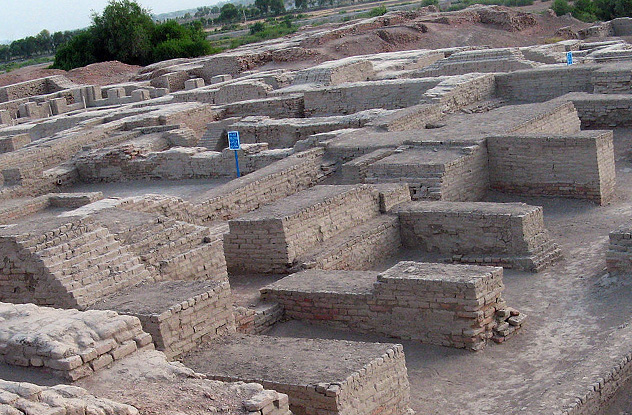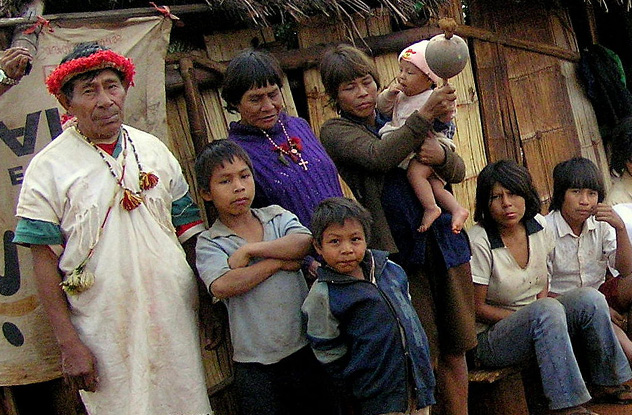 History
History  History
History  Technology
Technology Top 10 Everyday Tech Buzzwords That Hide a Darker Past
 Humans
Humans 10 Everyday Human Behaviors That Are Actually Survival Instincts
 Animals
Animals 10 Animals That Humiliated and Harmed Historical Leaders
 History
History 10 Most Influential Protests in Modern History
 Creepy
Creepy 10 More Representations of Death from Myth, Legend, and Folktale
 Technology
Technology 10 Scientific Breakthroughs of 2025 That’ll Change Everything
 Our World
Our World 10 Ways Icelandic Culture Makes Other Countries Look Boring
 Misconceptions
Misconceptions 10 Common Misconceptions About the Victorian Era
 Mysteries
Mysteries 10 Strange Unexplained Mysteries of 2025
 History
History 10 Things You Didn’t Know About the American National Anthem
 Technology
Technology Top 10 Everyday Tech Buzzwords That Hide a Darker Past
 Humans
Humans 10 Everyday Human Behaviors That Are Actually Survival Instincts
Who's Behind Listverse?

Jamie Frater
Head Editor
Jamie founded Listverse due to an insatiable desire to share fascinating, obscure, and bizarre facts. He has been a guest speaker on numerous national radio and television stations and is a five time published author.
More About Us Animals
Animals 10 Animals That Humiliated and Harmed Historical Leaders
 History
History 10 Most Influential Protests in Modern History
 Creepy
Creepy 10 More Representations of Death from Myth, Legend, and Folktale
 Technology
Technology 10 Scientific Breakthroughs of 2025 That’ll Change Everything
 Our World
Our World 10 Ways Icelandic Culture Makes Other Countries Look Boring
 Misconceptions
Misconceptions 10 Common Misconceptions About the Victorian Era
 Mysteries
Mysteries 10 Strange Unexplained Mysteries of 2025
10 Irreplaceable Treasures We’re About To Lose Forever
Everything dies. That’s the one guarantee of this universe of ours. Everything has its time, everything has its place, and nothing lasts forever. However, some of it could probably stand to last a little bit longer.
As you read this, the forces of nature, war, and human stupidity are conspiring across the globe to wipe out some superbly important stuff. These things define our shared history or simply enrich the world around us, and if we continue on our current course, they will soon be gone forever.
10The Majority Of Human Languages

Languages like English, Spanish, Russian, and Mandarin are spoken by millions—if not billions—of people. Even minor languages like Luxembourgish and Basque have hundreds of thousands of speakers and are in little danger of going extinct. But all of those languages, plus other minor ones like Welsh, Wu Chinese, and Adygean, are towering giants compared to the vast majority of human languages.
There are around 7,000 languages out there, 90 percent of which have fewer than 100,000 speakers. A large number of them are in danger of dying out. UNESCO currently lists nearly 2,500 languages as either vulnerable, endangered, or possibly extinct. That number is growing all the time. Over the last century, roughly three languages have gone extinct every month. If current trends continue, experts are predicting we’ll lose 50–90 percent of all languages by 2100.
When a language dies, an entire culture vanishes into the ether along with the collection of sounds. Many of these dying languages come from places where history and stories are recorded orally. Once the language goes, that culture’s memory goes with it, as happened when the last speaker of the 65,000-year-old Bo language died in 2010.
9Sumatra’s Diverse Rain Forests

Sprawling over an impressive 2.5 million hectares, Sumatra’s rain forests in Indonesia are one of the most diverse places on Earth. The only habitat in existence where you can find rhinos, orangutan, elephants, and tigers living side by side, it was named a UNESCO World Heritage Site in 2004. They harbor 100,000 plant species and 22 mammals found nowhere else in the world, and we’re in danger of losing them all.
Thanks to illegal logging backed up by eye-watering levels of corruption, Sumatra’s rain forests are being cleared at a rate of 3,000 square kilometers (1,000 mi2) each year. In 2014, it overtook Brazil—a country four times Indonesia’s size—to become the deforestation capital of the world. Over half the rain forest has already been lost in the space of a few short years, and we’re currently on course to chop down the whole thing by 2033.
The result would be mass extinctions across an area of land the size of Europe. Orangutan would be pushed further toward extinction, and we’d lose one of the most beautiful landscapes on Earth.
8The World’s Archives And Libraries
The destruction of the Library at Alexandria is rightly remembered as a cultural tragedy. Irreplaceable documents were lost forever, and centuries of human learning were extinguished. Yet this wanton act of destruction was far from a one-off. Today, dozens of archives across the globe are at immediate risk, many of them irreplaceable.
Most obviously, this includes the libraries in areas now under the control of ISIS. In January 2015, Mosul’s Central Library was torched by the terrorist group, destroying irreplaceable Ottoman-era texts. The archives of the city’s Sunni Muslim Library also went up in flames, as did the Mosul Museum Library. The latter contained unique texts dating back to 5,000 BC. Archives held in other war zones—such as South Sudan—face similar fates.
Simply driving the terrorists out isn’t always enough to save these archives. You might remember the story about Islamist rebels trying to destroy Timbuktu’s ancient manuscripts. The majority survived, thanks to the efforts of local residents to hide them. But the story didn’t end there. Once the rebels were driven out, it became clear that moving many of these manuscripts had left them in a desperately fragile condition. Two years later, they remain in immediate danger. Thanks to a global lack of interest now that the rebels have gone, the Timbuktu archives may yet be lost.
Go searching, and you’ll find dozens of similar stories, such as the ancient rock-carved records of Libya’s desert that are under threat from oil companies. Without a concerted global effort to save them, many of our great libraries may soon go the way of the one at Alexandria.
7Architecture’s Modernist Heritage

Nothing divides opinion quite like modernist architecture. For every elegant Villa Tugendhat, you have a great big brutalist monstrosity spoiling the skyline. Nonetheless, these buildings represent one of the most important artistic legacies of the 20th century. We’re knocking them down faster than you can say “cultural vandalism.”
Across Europe and North America, governments seem to be on a mission to demolish as many modernist buildings as possible. Pioneers like Paul Rudolph have had nearly every building they ever made pulled down—the architectural equivalent of burning every composition by John Cage. In London, dozens of icons of ’60s and ’70s brutalism are currently being destroyed, with little interest from the authorities in offering them listed status. Those scheduled for demolition include world-famous pieces like Robin Hood Gardens. In 2007, things got so bad that the World Monuments Fund officially listed modern architecture as an “endangered species.”
While many people hate the sight of modernist buildings, others argue that they’re an important part of our heritage. In a city like London, where you can still see the traces of every historical period going back centuries, demolishing only ’60s buildings feels like wiping out a period of history.
6Bolivia’s Most Sacred Mountain

For generations, El Cerro Rico has been terrorizing inhabitants of Potosi in Bolivia. A vast mountain that was once crammed so full of silver it single-handedly funded an empire, Cerro Rico was also the site of one of Imperial Spain’s most brutal labor camps. Local indigenous groups were sent down to mine in such dangerous conditions that it became known as the “mountain that eats men.” These twin legacies—a cross between El Dorado and Auschwitz—have seen it named a UNESCO World Heritage Site. Yet these 400 years of history are on the verge of being completely washed away.
Cerro Rico still contains silver. Every day, thousands of desperately poor Potosi locals are sent down the same shafts their great ancestors died in to extract more metal, and it’s beginning to take its toll. Cerro Rico is now so riddled with holes that authorities expect it to collapse at any moment. If mining continues, it may even take the city of Potosi with it. Although efforts are currently being made to stabilize the mountain, there’s no guarantee they’ll work. If they fail, one of Bolivia’s most important sites may soon be little more than a faded memory.
5A Generation Of Digital Data

We’re used to thinking of the Internet as permanent. Whatever we say or do online supposedly stays with us forever. So it can come as a shock to realize the Internet—in its current form—is far less stable than we think. According to Google boss Vint Cerf, everything in our online lives may soon be lost forever.
It’s all thanks to something called “bit rot.” While digitizing can preserve something for generations to come, its continued use depends on our being able to access it. As programs and hardware fall out of use, it can become impossible to retrieve data designed for old formats. Old emails, blogs, and videos can become lost forever. This has already happened to plenty of files stored on floppy disks in the 1990s. Unless you’re willing to part with the money for an external floppy drive, those old photos your Mom took in 1995 are probably now inaccessible. That’s only 20 years later. By the time we get to 2095, people will have as much idea of what a floppy disk is as you do a diplograph.
That’s before we take into account how even digital data degrades over time, causing defects like loud chirp noises on old MP3s. It’s totally possible some of those videos you made back in the pre-YouTube days and haven’t looked at since are already seriously damaged. Imagine what they’ll be like in 50 years, and you’ll see why this is a problem.
4Hundreds Of Cultural Traditions

Whenever you stick a bunch of humans together, you can be sure they’ll come up with rituals. Sometimes, as with frat house hazing rituals, they’re nothing to be proud of. Other times, such as Vanuatu’s land-diving ceremony, they’re awe-inspiring. Unfortunately, you’ll never get to see most of the thousands of local rituals that take place across the world. Many of them are in immediate danger of dying out.
Every year since 2009, UNESCO has produced a list of traditions and rituals in need of urgent safeguarding. Each entry tells of a way of thinking or way of life that’s on the verge of extinction. Mongolian calligraphy, for example, has been around for centuries but is now practiced by a mere 23 people. The Chinese art of Hezhen Yimakan storytelling now has only five living practitioners. Even Mexican mariachi music and traditional Chinese shadow puppetry are thought to be in danger of dying out in the not-too-distant future.
As these traditions vanish, so do the bonds that hold their communities together. If nothing else rises to take their place, the death of these rituals can leave a society in tatters.
3The World’s Oldest Surviving City

During an age when most humans were living in warring tribes, the ancient city of Mohenjo Daro in modern-day Pakistan was bringing together 35,000 people to live in harmony. Today, the site is one of the most archaeologically valuable in the world. It may be gone in as little as 20 years.
After the Indus civilization collapsed, Mohenjo Daro disappeared under the earth for nearly 4,000 years. It wasn’t until 1922 that it was finally excavated. Now that Mohenjo Daro is aboveground again, it’s starting to fall to pieces. The high salt content in the groundwater is eating away the ancient bricks, causing walls to collapse and ruins to deteriorate. Even worse, the Pakistani authorities have repeatedly bungled their attempts at conservation. Ancient walls have been buried under mud that actually increases the damage, and 4,000-year-old bricks have been taken away and simply replaced with modern ones. One politician even held a festival on the site, potentially causing untold damage.
Sadly, Mohenjo Daro isn’t unique in this respect. The Taj Mahal is being irreparably damaged by the pollution around it. The ancient Minaret of Jam in Afghanistan is on the verge of collapsing due to floods. Unless money can be found to conserve them, these awe-inspiring sites will not last much longer.
2Many Of The World’s Indigenous Tribes

There are currently somewhere in the region of 150 million tribal people living across the world, each tribe with its own sets of customs and rituals. Some of them live on the fringes of society, while others remain entirely uncontacted. According to charity Survival International, many of them are in immediate danger of dying out.
While some tribal cultures are disappearing simply because the young are entering globalized society, plenty of others are suffering violent fates. In Colombia, the Nukak lived away from regular contact until 1988. Then the civil war rolled into town, and with it came the drug trade. Since then, more than 50 percent of the tribe have been killed, and they are now considered on the verge of extinction. In Brazil, a campaign to evict them from their land has resulted in the Guarani suffering one of the highest suicide rates on Earth. In Tanzania, the Maasai have had their villages torched by the authorities.
As with language above, the death of these cultures means the death of entire histories and ways of seeing the world. Centuries of oral and religious traditions may very soon be lost—along with thousands of lives.
1The Biggest Countries On Earth

You’ve probably heard how places like Venice and Amsterdam will be underwater by the end of the century due to climate change. Entire countries may be devastated. You may not have heard exactly which countries will be affected most. According to Scientific American, it’s not the tiny Pacific islands or low-lying Netherlands who should be looking out. It’s China.
Thanks to its quirks of geography, China is extremely susceptible to droughts, typhoons, and sea-level rises—all hallmarks of a climate catastrophe. When the Yellow River burst its banks in 1887, 1931, and 1938, it killed more people than any other natural disaster in history. If climate change plays out as we’re expecting it to, those death tolls will start to look miniscule in comparison. A World Bank study placed China as by far the most vulnerable nation to climate change, followed up by India. Between them, the two countries account for roughly one-third of the world’s population and a huge percentage of its economy.



